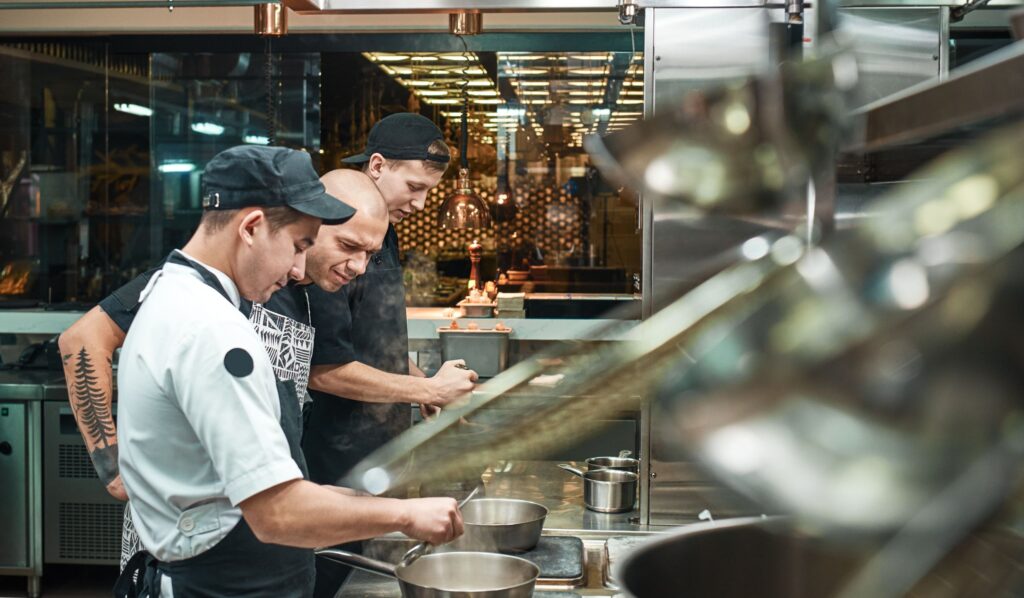Restaurants today spend a mere 1.97% of their gross annual revenue on technology, according to Hospitality Technology’s 24th annual tech study. That number pales compared to the nearly 7% the average U.S. business spends on technology. Given the furious pace of innovation — whether it be in French-fry-dunking or cocktail-servicing robots, automated ordering systems, or all-in-one restaurant management technology — that figure is likely to balloon in the coming years.
Yet for restaurant owners, operators, and managers who are constantly monitoring and thinking about those budgets, the question is how. As front-of-house technologies make it easier for diners to interact with their favorite restaurants, back-of-house technologies that empower operators to work more efficiently while expanding margins alongside overall growth will become increasingly important, especially in today’s environment with rising labor and ingredient costs. Below are some of the must-have tech tools that will help operators profit, grow, and provide continually improving guest experiences in 2024 and beyond.
Robust Integration
As the need for a comprehensive tech stack has become commonplace in restaurants, so too has the number of hours spent downloading, combining, uploading, examining, and correcting the data from various systems. When this happens, restaurant managers, leadership, and accounting teams are forced to spend untold hours on data entry and reconciliation rather than tasks that improve profits and diners’ experience. By ensuring your core restaurant management system easily integrates with the rest of your resources, particularly your point-of-sale (POS) system, vendors, and service partners, you eliminate busywork, empowering accounting teams to become advisors and store managers to become profit-driving operators,
Prime Cost Controls
Restaurant prime cost is the combination of each location’s ingredient and labor costs, which in most cases accounts for a whopping 60% to 65% of a restaurant’s total revenue. The ability, or inability, to accurately measure and control prime costs is directly correlated to a restaurant’s profitability. Ensuring access to accurate, real-time insights into your prime costs enables them to make margin-boosting decisions on the fly.
Actual vs. Theoretical Analysis
An actual vs. theoretical (AvT) food cost analysis showcases what you should have theoretically spent on inventory, based on sales, versus what you actually paid, accounting for errors and waste.
AvT analysis can help pinpoint where you can create efficiencies and reduce waste. Real-time AvT data provides an overview of actual usage, theoretical details of menu items sold, expected variance, and waste. With this information, you can quickly react to preserve and grow margins and profits.
Reporting, Forecasting, and Budgeting
While reporting is the common thread tying together many of the most critical tools for restaurant operators, there’s more below the surface. The ability to drill down into any report is essential to understanding what’s driving higher-level numbers. With limited availability of so many staples, a deep look into an item price change analysis report, for example, can provide insight into all deliveries of a particular ingredient, enabling you to spot when vendors made a higher-priced substitution that turned one of your highest margin dishes into a drag on profits.
The topline data from these reports also provide the groundwork for budgeting and forecasting. While much of the focus in restaurants is on the products and processes that provide guests with food and experiences, budgets and forecasts are the supporting foundation that ensures everything is moving in a positive direction. That means expanding margins, rising profits, better guest experiences, and growth.
Your budget is linked to your forecast, which is an estimate of key metrics like future sales, customer traffic, or menu item ordering mix based on historical sales data, economic trends, or market analysis.
Projected sales and customer traffic data can be used in different areas of restaurant operations, primarily in controlling prime costs. Inventory forecasting is calculating the precise amount of future inventory and production needs for your restaurant. It also accounts for historical consumption patterns and the shelf life of finished products. Labor forecasting, ultimately, is about delivering a positive customer experience with the optimal lowest labor budget.
The best forecasting depends on how you manage information, how much data you can access, and the unique factors that influence your business plan. While accounting and finance teams once struggled to do this manually, operators today need a dedicated, integrated platform that automatically combines your inventory, sales, and labor to quickly produce forecasts and budgets that can guide you through the coming year or an unexpected crisis.
Bank Integration
Manual bank reconciliation can be a tedious, error-prone process. Some restaurant groups report that it consumes about 20 percent of their accounting teams’ time, worth countless hours each year. By ensuring your restaurant accounting and management platform seamlessly connects with financial institutions, bank reconciliation can be completed within minutes.
When bank reconciliation is automated, you can immediately identify discrepancies, which means you can easily reconcile accounts daily. This practice can dramatically reduce your financial exposure to payment errors and fraud while allowing you to immediately address any errors before they escalate.
A Modern General Ledger
The general ledger (GL) got its name because it was originally a physical binder or “ledger.” Today, a general ledger is still comprised of all the individual accounts of assets, liabilities, equity, revenue, and expense transactions. However, when general ledger and accounting systems aren’t connected, restaurant accounting teams spend untold hours pulling information from various systems and uploading it into the GL. Creating high-level reports becomes a cumbersome process. If an accounting or other error occurs, the time required to find and correct it at the source could further damage the company.
By ensuring your GL is an integral part of your accounting and restaurant management platform, purchases, as well as sales and receipt details from the POS system, are automatically mapped to the corresponding GL accounts using sales accounts (credits) and payment type accounts (debits). It also automatically creates labor accrual journal entries for the general ledger, offering an accurate, real-time picture of the business.
Seamless Communication
Just as the GL was once a physical item, so were managers’ logbooks. In it, each manager would note what happened during each shift and what should happen in the following shifts to share critical information with fellow leaders. By digitizing that logbook, managers can provide a concise overview of their shift and more easily share critical tasks, giving the next day or next shift’s manager a clear picture of what they are walking into and should prioritize.
Streamlined Recruiting, Hiring, and Onboarding
With steadily rising labor costs and a smaller pool of applicants, it’s harder than ever for restaurants to build their dream teams. Despite those roadblocks, operators, and managers continue to struggle with disparate tools and systems to attract and recruit top talent, move them swiftly through the interview phases, and onboard and train them, so they hit the ground running, ready to grow alongside the business.
Rather than trying to cobble together a solution from disjointed pieces, restaurant leaders need an all-in-one hiring tool that creates a professional careers page, posts job openings in multiple places with a single click, simplifies applicant communication, and helps new hires to onboard themselves so managers can focus on training to provide best-in-class guest experiences as quickly as possible.
Conclusion
While each one can drive value individually, what’s most important is that all of the tools and functionalities mentioned above not only be used by growth-focused operators looking to grow through in any situation but that they all work coherently within a single system. By doing so, restaurant companies can leverage knowledge-and-data-based economies of scale, enabling them to more easily and efficiently oversee and operate each location, and the entire company, to consistently grow and, most importantly, provide unforgettable guest experiences.



